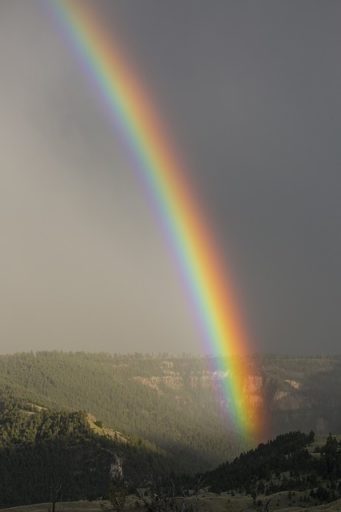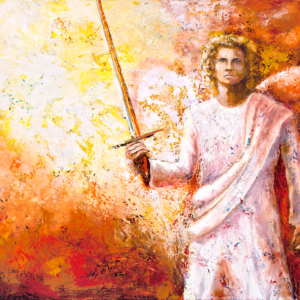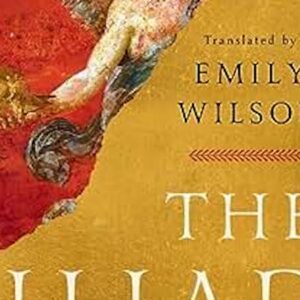I’m sitting in my reading chair, legs propped on the ottoman, computer on my lap. Across the room I see the beautifully crafted wooden file cabinets that I bought at a local crafts sale. On the table to my left are the potted plants that my husband tenderly keeps thriving. Through the window behind them I see my back yard, with its statue of St. Francis created out of metal by a friend who is a sculptor.
In all this observation, am I seeing reality? Not quite—according to both Robert Cording, in his new collection of essays, Finding the World’s Fullness (Slant, 2019), and Claude Wilkinson, in his new poetry collection, World Without End (Slant, 2020). Both would say that I’m seeing appearances, but not truly reality.
What am I missing? Cording would say I’m missing the “fullness” of the moment: “what the novelist Marilynne Robinson referred to in Gilead as a ‘thing existing in excess of itself.'” Wilkinson would recite almost any lines from World Without End, which enact this fullness. Like the final lines of “Sunday Morning Wildflowers”:
… under
the cumulus, blue of beginning September
were sprinkled so many miracles
of slender stems crowned with orange, pink,
yellow et cetera of poppies, lace, and daisies
gently swaying from a cat’s-paw breeze,
every flower sharing its happy ministry,
burning with some beautiful understanding.
I’m missing, that is, the “miracles” of these flowers lovingly caressed by the poet’s language; I’m missing their “happy ministry”; I’m missing the “beautiful understanding” that burns within everything I look at. (Notice that it’s the flowers that burn with understanding… not the viewer of them.) I’m missing what Wilkinson describes in his interview about this book as “the seemingly infinite spiritual implications woven throughout our experiences of the natural world.”
Cording expands on these “spiritual implications” in his essay on nature poetry, “To Discover an Order as of a Season.” The nature poet’s task, Cording says, is “the revelation of presence, an awakening to the astonishing sense that things are, though they need not be.” Further, paraphrasing Wallace Stevens (whom Cording frequently quotes throughout his essays), Cording points to “the nature poem’s search for a reality and meaning outside the mind’s constructions.”
I see all this going on in Wilkinson’s poem “Covenant” (the title referring to the covenant God made with Noah after the flood). Here’s the entire poem:
Arcs of a double rainbow
tie our world to violet clouds
moments before rose afterglow
over the tops of cottonwood,
across slick lawns, again promising
everything left will dry and be safe.
Those little olive-gold birds
with the feathers that look
like cloisonné know it.
Damp sparrows dipping through
passages in silvery mist
must have also gotten a word.
Drowning here and there
are katydids and beetles,
but there is also this remnant of music
that’s said to have once surrounded us.
And what blue morning glories,
what full hollyhocks, and all
manner of flowers rejoicing,
raising their heads for praise!
I love where this poem goes after the promise that “everything left will dry and be safe” following the deluge. It’s the delightfully attentive language that enchants me. The little birds who are specified not only by their olive-gold color but also, unexpectedly, by feathers like “cloisonné”—which took me to the dictionary. (It’s decorative enamelwork in which metal filaments are fused to the surface of an object to outline a design that’s filled in with enamel paste.) Then the “Damp sparrows dipping through / passages in silvery mist”: I can feel the weight of their wetness in the alliterative damp and dipping, sparrows and silvery, and in the assonance of silvery mist.
Then we move from the sadly drowning katydids and beetles toward a glorious finish: the music of the spheres taking us heavenward, the morning glories intimating gloriousness, the rejoicing of “all manner of flowers” expressing their “praise.”
And of course the “full hollyhocks”—which return me to Robert Cording’s “fullness.” Here’s how Cording opens his title essay, “Finding the ‘World’s Fullness'”: “I want to argue why it is crucial to hold open the possibility that, as Richard Wilbur lovingly puts it, ‘the world’s fullness is not made but found.'” (The quotation is from Wilbur’s poem “Wedding Toast.”) Our task as writers and readers and observers, then, is to find the world’s fullness.
How do we find it? For Cording, attention is how we find the world’s fullness. Some of his essays address this directly: “Acts of Attention: Some Thoughts on Poetry and Spirituality”; “Love Calls Us to One World at a Time” (this title playing off of Wilbur’s famous poem “Love Calls Us to the Things of This World”); and “The Art of Devotion: Poetry and Prayer” (with its epigraph quoting Simone Weil: “Attention, taken to its highest degree, is the same thing as prayer”).
Attention, for Cording, requires first of all the disappearance of the self. Being able to see “the fullness that exists in each moment,” he writes, “is an exercise in overcoming one’s self, in attending to something quite particular other than oneself.” Thoreau is a model for Cording, because “Thoreau’s attentiveness is a kind of spiritual discipline, an exercise of constantly attending to the uniqueness and particularity of the world around him.”
From Thoreau, Cording moves to Iris Murdoch. (Cording is admirably humble in drawing frequently on other writers, among whom are some of my favorites as well: not only Thoreau, Murdoch, Marilynne Robinson, Wallace Stevens, and Richard Wilbur, but also Czesław Miłosz, Simone Weil, Wendell Berry, and more). “Thoreau,” Cording writes, “helps us think about what Murdoch calls ‘the transcendence of reality,’ those moments… when we are returned to our senses and experience the joy which Weil defined as the ‘overflowing consciousness of reality.’ It is a moment of transfiguration where the ordinary becomes extraordinary.”
And great art, according to Murdoch, can draw us into these transfigurative moments—these moments of fullness—by showing us how to look at “the real world.” We must look “with morally disciplined attention,” which requires “patiently and continuously a change of one’s whole being in all its contingent detail, through a world of appearance toward a world of reality…”
…as Claude Wilkinson helps us see at the end of his poem “Winter Field White with Snow Geese.” The speaker, “nearing yesterday’s bland fields,” is startled by “such a blizzard of honking and descending splendor” that it becomes
my own segue
out of the world’s apathy
as these many thousand white blessings
offer their random seconds of beauty.
Peggy Rosenthal has a PhD in English Literature. Her first published book was Words and Values, a close reading of popular language. Since then she has published widely on the spirituality of poetry, in periodicals such as America, The Christian Century, and Image, and in books that can be found here.





